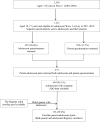Parent Physical and Mental Health Comorbidity and Adolescent Behavior
- PMID: 29249908
- PMCID: PMC5730089
- DOI: 10.4172/1522-4821.1000358
Parent Physical and Mental Health Comorbidity and Adolescent Behavior
Abstract
The objectives of this study were to ascertain behavioral outcomes 10-11 years after 9/11 in adolescents ages 11-18 years (0-8 years old at the time of 9/11) enrolled in the World Trade Center Health Registry (Registry), and relate these outcomes to their 9/11-exposures and to parent health. Behavioral difficulties among adolescents were assessed using the adolescent-reported Strengths and Difficulties Questionnaire (SDQ). Parental post-traumatic stress disorder (PTSD) was assessed using a 9/11-specific PTSD Checklist-Civilian Version, a cut-off score of 44 or greater was considered probable PTSD. Multivariable logistic regression was used to estimate associations of 9/11-exposure and parental health with abnormal/borderline SDQ scores, adjusting for demographic variables that were significantly associated with the SDQ score in bivariate analyses. Of the 449 adolescents, 12.5% (n=56) had abnormal/borderline SDQ scores. In the multivariable model, adolescents with severe/ moderate 9/11-exposures were 2.4 times more likely to have abnormal/borderline SDQ scores compared to adolescents with mild 9/11-exposures (95% Confidence Interval (CI): 1.1-6.4). Adolescents who had a parent with 9/11-related PTSD and at least one comorbid chronic condition were 4.2 times more likely to have abnormal/borderline SDQ scores compared to adolescents with a parent who had no reported chronic health conditions. Adolescents whose parent reported 14 or more poor mental health days in the preceding 30 days were 3.4 times more likely to have abnormal/borderline SDQ scores (95% CI: 1.2-9.5) The finding that parents' health appears to influence adolescent behavior problems 10-11 years following a disaster may have implications for healthcare practitioners and disaster response planners.
Keywords: Adolescent; Behavior Problems; World Trade Center.
Similar articles
-
Behavior problems in adolescence and subsequent mental health in early adulthood: results from the World Trade Center Health Registry Cohort.Pediatr Res. 2018 Aug;84(2):205-209. doi: 10.1038/s41390-018-0050-8. Epub 2018 Jun 15. Pediatr Res. 2018. PMID: 29907850 Free PMC article.
-
Adolescent behavior and PTSD 6-7 years after the World Trade Center terrorist attacks of September 11, 2001.Disaster Health. 2015 Feb 3;2(3-4):121-129. doi: 10.1080/21665044.2015.1010931. eCollection 2014 Jul-Dec. Disaster Health. 2015. PMID: 28229007 Free PMC article.
-
Concurrence of the strengths and difficulties questionnaire and developmental behaviour checklist among children with an intellectual disability.J Intellect Disabil Res. 2018 Feb;62(2):150-155. doi: 10.1111/jir.12426. Epub 2017 Oct 5. J Intellect Disabil Res. 2018. PMID: 28980362
-
Validation of the parent version of the Strengths and Difficulties Questionnaire (SDQ) to screen mental health problems among school-age children in Mongolia.BMC Psychiatry. 2021 Apr 29;21(1):218. doi: 10.1186/s12888-021-03218-x. BMC Psychiatry. 2021. PMID: 33926396 Free PMC article.
-
Respiratory health of 985 children exposed to the World Trade Center disaster: report on world trade center health registry wave 2 follow-up, 2007-2008.J Asthma. 2013 May;50(4):354-63. doi: 10.3109/02770903.2013.776073. J Asthma. 2013. PMID: 23414223
Cited by
-
Behavior problems in adolescence and subsequent mental health in early adulthood: results from the World Trade Center Health Registry Cohort.Pediatr Res. 2018 Aug;84(2):205-209. doi: 10.1038/s41390-018-0050-8. Epub 2018 Jun 15. Pediatr Res. 2018. PMID: 29907850 Free PMC article.
-
Post-Traumatic Stress Disorder Is Associated with Elevated Plasma Cholesterol in Female TT Homozygotes of LDLR rs5925.Int J Mol Sci. 2023 May 19;24(10):9016. doi: 10.3390/ijms24109016. Int J Mol Sci. 2023. PMID: 37240367 Free PMC article.
-
Association of maternal and paternal adverse childhood experiences with emotional and behavioral problems among preschool children.Eur Child Adolesc Psychiatry. 2025 Mar;34(3):1111-1123. doi: 10.1007/s00787-024-02542-3. Epub 2024 Aug 10. Eur Child Adolesc Psychiatry. 2025. PMID: 39126496
-
Hospitalizations among World Trade Center Health Registry Enrollees Who Were under 18 Years of Age on 9/11, 2001-2016.Int J Environ Res Public Health. 2021 Jul 15;18(14):7527. doi: 10.3390/ijerph18147527. Int J Environ Res Public Health. 2021. PMID: 34299982 Free PMC article.
References
-
- Anmyr L, Larsson K, Olsson M, Freijd A. Strengths and difficulties in children with cochlear implants–comparing self-reports with reports from parents and teachers. International Journal of Pediatric Otorhinolaryngology. 2012;76(8):1107–1112. - PubMed
-
- Bayliss M, Rendas-Baum R, White MK, Maruish M, Bjorner J, Tunis SL. Health-related quality of life (HRQL) for individuals with self-reported Chronic Physical And/Or Mental Health Conditions: Panel Survey Of An Adult Sample In The United States. Health and Quality of life outcomes. 2012;10(1):154. - PMC - PubMed
-
- Berninger A, Webber MP, Weakley J, Gustave J, Zeig-Owens R, Lee R, et al. Quality of life in relation to upper and lower respiratory conditions among retired 9/11-exposed firefighters with pulmonary disability. Quality of Life Research. 2010;19(10):1467–1476. - PubMed
-
- Blanchard EB, Jones-Alexander J, Buckley TC, Forneris CA. Psychometric properties of the PTSD Checklist (PCL) Behaviour Research and Therapy. 1996;34(8):669–673. - PubMed
Grants and funding
LinkOut - more resources
Full Text Sources
Other Literature Sources

